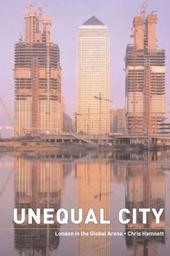
|
Unequal City: London in the Global Arena
Paperback
Main Details
| Title |
Unequal City: London in the Global Arena
|
| Authors and Contributors |
By (author) Chris Hamnett
|
| Physical Properties |
| Format:Paperback | | Pages:304 | | Dimensions(mm): Height 234,Width 156 |
|
| Category/Genre | Human geography |
|---|
| ISBN/Barcode |
9780415317313
|
| Classifications | Dewey:307.1409421 |
|---|
| Audience | | Undergraduate | | Postgraduate, Research & Scholarly | | Professional & Vocational | |
|---|
| Illustrations |
45 line drawings, 3 b&w photographs, 39 tables
|
|
Publishing Details |
| Publisher |
Taylor & Francis Ltd
|
| Imprint |
Routledge
|
| Publication Date |
26 June 2003 |
| Publication Country |
United Kingdom
|
Description
Unequal City examines some of the dramatic economic and social changes that have taken place in London over the last forty years. It describes how London's changing industrial structure, particularly the shift from an industrial to a services-based city, and the associated changes in occupational class structure and in the structure of earnings and incomes, have worked through to the housing market and the gentrification of large parts of inner London. This has had major consequences for both the social structure and the built environment of London. It asserts that this transformation in London's industrial structure, from a city with a large manufacturing base to one based primarily on business, financial, creative and other services, is linked to a major change in its occupational structure. But, unlike much of the literature, which argues that cities like London have become increasingly socially polarised, it argues that London has become more professionalised and has a shrinking manual workforce. The changes in the industrial and occupational structure of London have been linked to changes in its earnings and income structures. The dominant feature of London has been an expansion of its high earning groups and a marked increase in both earnings and income inequality. The growth of this expanded new middle class has had major impacts on the nature of the London housing market, particularly in the growth of home ownership, rising prices and the expansion of middle class gentrification across much of inner London. This has been paralleled by the growing marginalisation of the less skilled, the unemployed and various minority groups in the council sector. These changes have reshaped the social structure and social geography of London. They have made it a more unequal city. Unequal City relates to the literature on global cities. The book has a wide sweep and summarises a wide range of literature on occupational and industrial change, earnings and incomes and the housing market and gentrification. It provides a wealth of original data, figures, maps and tables and will be a valuable reference for anyone interested in the changes that have reshaped the social structure of London in recent decades.
|